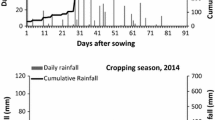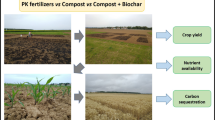Abstract
Vermicomposting is very popular worldwide due to its ability to convert the organic waste to manure as a substitute for chemical fertilizers. Organic agriculture aims to reduce the dependence of chemical fertilizers and attempts to incorporate crop residues or other forms of organic materials to provide nutrients, which improves soil structure and maintains the soil fertility. During crop cultivation, crop residues are produced in large quantities. The sugar industry is a major agro-industry in India and it is water-intensive crop. The sugarcane crop produces large quantities of crop residues which have high nutrient value. These crop residues can be a great help in improving soil fertility. Thus, the recycling of these crop residues gain worthwhile importance. This chapter discusses the findings of a case study wherein the decomposed bagasse was used as organic compost in cane fields as 3 Mt per acre. The compost was recommended to use continuously for 3 years to increase the organic carbon content in soil. In, drought prone areas, 5 Mt of compost per acre of land was recommended for water conversation. Bagasse has high water holding capacity and it has a water holding capacity of 1:5 ratio by its weight. Bagasse when applied to soil it slowly release the moisture to the soil and holds the soil water capacity. Hence, the frequency of irrigation in cane in red soil is reduced from alternate days to once in 4 days of irrigation. The sugarcane crop was applied with sugarcane bagasse compost which was low in cost followed by cane trash in situ composting. It improved the organic carbon, water absorption, and texture of the soil, which resulted in higher productivity of the crop. The bagasse compost also gave vigorous growth in young seedlings. The results described the advantages of bagasse composting which has high nutrient value and improved the organic carbon content of the soil. The high growth of cane seedlings will enhance the cane production and its various economic benefits can be realized in future.
Access this chapter
Tax calculation will be finalised at checkout
Purchases are for personal use only
Similar content being viewed by others
References
Chatterjee R, Gajjela S, Thirumdasu RK (2017) Recycling of organic wastes for sustainable soil health and crop growth. Int J Waste Resour 7:296. https://doi.org/10.4172/2252-5211.1000296
Hanine S, Agnieszka R, Anna G, Anna G, Marcin M, Barbara P, Małgorzata K, Franck V (2017) Determination of the performance of vermicomposting process applied to sewage sludge by monitoring of the compost quality and immune responses in three earthworm species: Eisenia fetida, Eisenia andrei and Dendrobaena veneta. Bioresour Technol 241:103–112
Jinu E, Kee-Choon P (2019) Effect of vermicompost application on root growth and ginsenoside content of Panax ginseng. J Environ Manag 234:458–463
Mahaly M, Abbiramy K, Senthilkumar A, Chitrapriya K, Nagarajan K (2018) Vermicomposting of distillery sludge waste with tea leaf residues. Sust Environ Res 28:223–227
Nagavallemma KP, Wani SP, Stephane L, Padmaja VV, Vineela C, Babu Rao M, Sahrawat KL (2004) Vermicomposting: recycling wastes into valuable organic fertilizer. Global Theme on Agroecosystems Report no. 8: International Crops Research Institute for the Semi-Arid Tropics, Patancheru, Andhra Pradesh, p 20
Priyanka U, Alka S (2017) An economic analysis of sugarcane cultivation and its productivity in major sugar producing states of Uttar Pradesh and Maharashtra. Econ Aff 62:711–718
Sánchez-Monedero MA, Roig A, Paredes C, Bernal MP (2001) Nitrogen transformation during organic waste composting by the Rutgers system and its effects on pH, EC and maturity of the composting mixtures. Bioresour Technol 78:301–308
Sharma HR (2005) Agricultural development and crop diversification in Himachal Pradesh: understanding the patterns, processes, determinants and lessons. Indian J Agric Econ 60:71–93
Xiao Z, Liu M, Jiang L, Chen X, Griffiths BS, Li H, Hu F (2016) Vermicompost increases defense against root-knot nematode (Meloidogyne incognita) in tomato plants. Appl Soil Ecol 105:177–186
Yadav A, Garg VK (2019) Biotransformation of bakery industry sludge into valuable product using vermicomposting. Bioresour Technol 274:512–517
Yaxin Z, Ye T, Duofei H, Jinshi F, Maocai S, Guangming Z (2019) Is vermicompost the possible in situ sorbent? Immobilization of Pb, Cd and Cr in sediment with sludge derived vermicompost, a column study. J Hazard Mater 367:83–90
Zhang X, Wang X, Wang D (2017) Immobilization of heavy metals in sewage sludge during land application process in China: a review. Sustainability 9:1–19
Zhenggao X, Manqiang L, Linhui J, Xiaoyun C, Bryan Griffiths S, Huixin L, Feng H (2016) Vermicompost increases defense against root-knot nematode (Meloidogyne incognita) in tomato plants. Appl Soil Ecol 105:177–186
Author information
Authors and Affiliations
Corresponding author
Editor information
Editors and Affiliations
Rights and permissions
Copyright information
© 2020 Springer Nature Switzerland AG
About this chapter
Cite this chapter
Siva Rani, J. (2020). Current Trends and Insights on Compost Utilization Studies: Crop Residue Composting to Improve Soil Organic Matter in Sugarcane Cultivation, Tamil Nadu, India . In: Meghvansi, M., Varma, A. (eds) Biology of Composts. Soil Biology, vol 58. Springer, Cham. https://doi.org/10.1007/978-3-030-39173-7_12
Download citation
DOI: https://doi.org/10.1007/978-3-030-39173-7_12
Published:
Publisher Name: Springer, Cham
Print ISBN: 978-3-030-39172-0
Online ISBN: 978-3-030-39173-7
eBook Packages: Biomedical and Life SciencesBiomedical and Life Sciences (R0)




